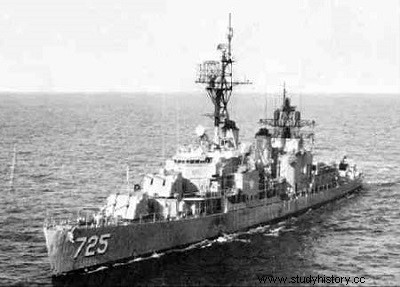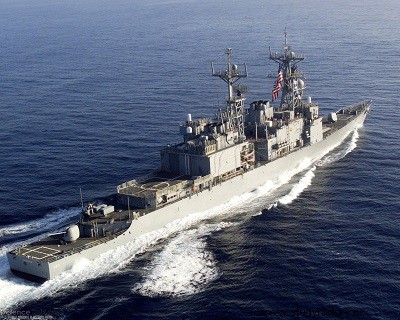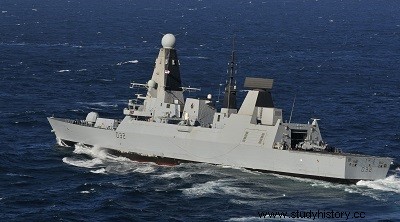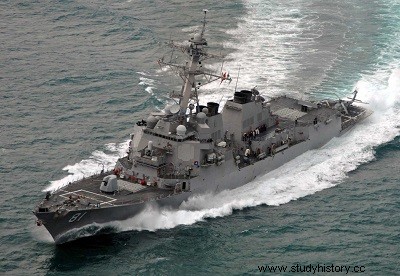
In modern military terminology, a destroyer (in France a counter- torpedo boat, until the end of World War II) is a warship capable of defending a group of buildings (military or civilian) against any threat, such as attacking a group of moderately defended ships. It has anti-aircraft, anti-submarine and anti-ship means. Originally, the term referred to a building that had to attack with torpedoes, while defending with medium caliber artillery a squadron or a convoy attacked by buildings of the same type.
Origin
The destroyer appeared in the United Kingdom shortly after the Chilean Civil War of 1891 and the Sino-Japanese War (1894-1895), two conflicts where small torpedo boats proved their effectiveness.
These small ships, extremely fast for the time, manage, thanks to their small size, to approach the distance necessary to launch their torpedoes, against the slow behemoths that are the battleships of this time. They can therefore cause considerable damage, for a derisory cost of ownership, even if they are destroyed. They are particularly dangerous when used in combination with friendly battleships, with enemy ships having the option of either protecting themselves against them or fighting enemy battleships. The assailant, given the price of this "naval dust", having then, whatever happens, acquired a certain advantage.
The need for a ship specially designed to sink them, screen in front of large units, is felt; Thus was born the torpedo catcher (literally “catcher of torpedo boats”) then the torpedo boat destroyer (“destructor of torpedo boat”), soon abbreviated to “destroyer” and which took the name in the French navy of “counter-torpedo boat”. The idea is to build ships that are faster than torpedo boats, but armed with guns with a high rate of fire and no longer exclusively with torpedoes. By operating in front of the line fleet, they prevent the torpedo boats from reaching a position to launch their torpedoes on the large buildings. However, the concept is evolving very quickly, because these new small ships are also likely to find themselves confronted by enemy battleships and it is therefore decided to arm them too with torpedoes. In addition, the destroyer must be able to operate with the fleet and therefore be able to follow it, unlike the torpedo boat which acts near its bases. Eventually, the destroyer becomes a much more important building than the one it has to fight.
The first success of the concept took place in the United Kingdom, with the launch of the two Havock-class ships. The destroyer ends up, because of its torpedoes on board, by taking over the missions of the ships it is responsible for destroying, that is to say the rapid attack with torpedoes. A first example was given by the Japanese at Port-Arthur in 1904. The torpedo boat ended up designating in the French navy a small destroyer with a short range of action, the role of the pure torpedo boat, the attack near the coast, being ensured by torpedo boats and other "motor-boats".
During the interwar period, the French Navy built thirty-two destroyers characterized by their high speeds and large tonnages. The fastest, Le Terrible, made 45.03 knots during its trials in 1935 for a “Washington” displacement of 2,569 tons, which remained the world sea speed record for a long time.
The heaviest and most powerful, the Volta and Mogador, in 1938, reached a displacement of 4,015 tonnes at full load. This tonnage has never been achieved at this time for a ship of this type in any other navy in the world. In its high-powered tests, the Mogador reached 43.45 knots, developing 118,320 hp, which is a power record on two lines of propeller shafts, at a “Washington” displacement of 3,015 tonnes.
Evolution
New York Shipbuilding Corporation shipyard, in Camden (New Jersey), in 1919.
Le Fantasque in 1944 after its modernization in the United States. It belonged to the fastest class of combat ships over 2,500 tons in the world until the commissioning of the Littoral combat ships in the 2010s.
During the First World War, the generalization of the danger of submarines led destroyers to ensure another mission:the protection of large units against these new enemies within the squadrons. The convoys, when they began to be structured, made more use of specialized anti-submarine escorts, the sloops then, soon, at the start of the Second World War, the corvettes and frigates which, because of the ships they are supposed to protect, are much slower than destroyers or destroyers but much more enduring at sea and with a better radius of action due to the distances to be covered.

Destroyer armament and tactics must evolve for this mission and thus appear the underwater grenades which end up being launched by mortar, the asdic then the sonar to detect the submarines. In contrast, destroyers, thanks to their high speed, are often able to ram submarines before they can dive deep. Thanks to their high speed, they can carry out raids near hostile coasts and disrupt enemy convoys. The offensive capabilities of destroyers against surface targets suffer, sometimes guns and torpedo tubes are dismantled to make way for anti-submarine equipment but, more generally, there is an inflation of displacement to be able to fill efficiently all missions and the appearance of destroyers specializing in protection, the "escort destroyers", which are initially made by the evolution of old buildings. This is even more true when the Second World War adds aerial danger to the underwater threat. Destroyers must then embark new weapons to fight it. Anti-aircraft artillery was therefore installed in large numbers, then navigation, aerial surveillance and artillery control radars and, finally, surface-to-air missiles. Soon, the increase in size is no longer possible and one begins to specialize ships for certain roles. The offensive mission experiences a post-war eclipse due to the declining effectiveness of guns and torpedoes in modern combat. It has during this period only two defensive roles, against the submarine and against the plane. During the 1970s, the possibility of mounting sea-to-sea missiles, which had become less cumbersome and more reliable, made this role reappear, in a new form.

Nowadays the name destroyer is more of a traditional appellation, which varies from country to country, the terms "destroyer", "frigate", "corvette" and "escadre escort", are very often used for ships with very similar characteristics. Sometimes their displacement allows them to be classified as a light cruiser. Versatility is their key word, because even if they are more specialized in a particular mission (anti-aircraft, anti-submarine or anti-surface warfare), they still have capabilities in other areas. Another feature that emerged in the early 1950s, and subsequently became widespread, was the presence of on-board helicopters. These rotary wings can fulfill several missions, anti-submarine warfare, missile guidance beyond the radar horizon, helicopter assault, reconnaissance and rescue at sea, which greatly contributes to the increase in the tasks that can be entrusted to these ships, allowing them to operate away from their bases in isolation.
In France

Even if one can read quite often in non-specialized journals or foreign translations:the French destroyer…, France uses the designation of destroyer only on one occasion:between 1943 and 1967, for the 14 "destroyers escort” (DE) built in the United States during the Second World War and designed for anti-submarine warfare. Although officially listed as "escort torpedo boats" in the combat fleets of 1947 and then escorts, the designation of escort destroyers or "D E", will always be used by sailors until the end of their career. /P>
The buildings originally intended to fight the torpedo boats, are simply called "counter-torpedo boats", a term which appears for the first time in the ministerial decree of March 17, 1886, which orders the transformation of the ten torpedo boats numbered from 65 to 74, by mounting four 37 mm revolver guns; ultimately only No. 68 will be converted. In February 1888, the "gun boat" Gabriel Charmes, originally armed with a 138.6 mm gun. It will also be transformed into a destroyer and will carry the number 151. In 1890, they are all reclassified as torpedo boats.
The designation reappeared in 1896, when the "aviso-torpilleurs" Cassini, D'Iberville and Casabianca were reclassified as "destro-torpilleurs d'escadre". The two Dunois and Lahire also receive this designation as soon as they are put into service. The Condor class, first classified as a torpedo cruiser, also adopted it, as did the 3rd class cruiser, Milan in 1897.
In 1901, the squadron destroyers officially became destroyers and were built:32 of 300 tons, 13 of 450 tons and 21 of 800 tons. The designation was changed again in 1914, to "torpedo boat".
The term destroyer reappears on the occasion of the naval program of 1922, which provides for twelve. Six 2,100 ton Jaguar class and six 2,400 ton Cheetah class. Twenty others will follow:six Aigle, six Vauquelin also of 2,400 tonnes, six Le Fantasque (2,600 tonnes), finally two Mogador (2,800 tonnes) only will be built out of the six planned. Four of the six of the Le Fantasque type which survived the battle at Dakar and the scuttling of Toulon, were reclassified as light cruisers after their modernization in the United States in 1943 and 19442. In 1951, they were reclassified as 1st class escorts by analogy with the T47 then under construction.
Admiral Lemonnier, former chief of staff of the French navy, in an article which he signed in 1938 in the Revue maritime under the title "Apologie du contre-torpilleur", wrote:"[...] The French navy distinguished by the characteristic choice of a tonnage of 2,200 to 2,500 tons and especially by its perseverance in a program that no one imitated to such an extent that for ten years, one could wonder if we were not on the wrong track. Our navy took risks; a success, today undisputed, has rewarded it. It can proudly claim its creation and recall that for ten years, we were able to say with good reason:the destroyer, a French product...”
In 1951, the designation “destroyers” gave way to that of 1st class destroyer-escorters, then in 1954 to that of “escadre escort” which better reflected the missions. It appears with the launch of the eighteen squadron escorts, divided into twelve of the “T 47” type, then five “T 53” and one “T 56”. These buildings have the mission of ensuring the protection of the squadrons of heavy or precious buildings. During their careers, three will be recast as flotilla leaders, four as anti-aircraft missile launchers (BLM) equipped with American Tartar missiles and seven as anti-submarine escorts equipped with a towed sonar and torpedoes carried by a Malafon missile.
To protect convoys and commercial navigation from submarines, the classification of "fast escort" is instituted. Eighteen fast escorts will be built from 1950. The first four will be those of the "E50" type, followed by eleven "E52A" and then three "E52B". They will be largely inspired by the escort destroyers (DE) built for the US Navy during the Second World War. The Vendéen, which will be the last fast escort in service, will be decommissioned in 1981.
Within this class of ocean-going escorts, the first seven E52As will be funded by the United States under the Military Assistance Program (MAP)
To maintain France's sovereignty in the overseas departments and territories, nine Victor Schoelcher-class "aviso escorts" were launched from 1958. The term frigate reappeared in the French Navy from 1962, with the Suffren and Duquesne which are first classified as missile-launching frigates then frigates and missile-launching buildings. In 1965, the designation of corvette was adopted for the launch of the Aconit, then the three Tourvilles which were reclassified as frigates as soon as they were commissioned. In 1988, the Aconit and the seven anti-submarine corvettes of the Georges Leygues class were also reclassified as frigates, so the term corvette disappeared in the French Navy.
Aconit disarmed in 1997, Duguay-Trouin in 1999, Suffren in 2001 and Duquesne in 2007, Tourville in 2011 and De Grasse in 2014.
In 1992, the last squadron escort, the Duperré, was disarmed, the designation disappeared with it. In 1996, the last escort sloop L'Enseigne Henry suffered the same fate. Nowadays, only the frigate designation seems to prevail in the French Navy. When the last sloop of the Estienne d'Orves class is disarmed, the sloop type will also have disappeared.
The frigates are now divided into two ranks. Those of the first rank identified by the letter D ("Destroyer" according to the terminology adopted in 1950 by certain navies of Western Europe4) preceding a three-digit number and composing their visual callsign, and those smaller, of second rank, by the letter F (“Frigate” according to the same terminology).
The French naval lists then include or will include:
First class frigates.
air defense (FDA) or anti-aircraft (FAA) frigates
anti-submarine frigates (FASM)
Second-rate frigates.
light stealth frigates (FLF) which according to the 2008 defense white paper could become "first class"
surveillance frigates (FS)
avisos (Type A69, decommissioned offshore patrol boats.
Formations and tactics
During the period when destroyers fulfilled their traditional role of attack and protection in torpedo actions, they were employed in a grouped and coordinated fashion. The basic formation employing destroyers at the time was the “flotilla”, the size of which varied according to the nations and generally included four to ten destroyers. The building commanding the unit was named "flotilla leader", depending on the country; again, it was either a light cruiser or a destroyer itself, but often larger in size with additional arrangements to fulfill command functions, carrying a flag officer (admiral) and his staff. The flotilla was also supported by supply ships which allowed it to act far from a land base. The small size of the destroyer, in fact, made it impossible, at least in the early stages, to reload the torpedo tubes on board, requiring the intervention of a heavier ship equipped with suitable lifting equipment. In addition, these fast ships quickly consumed their fuel reserves. Isolated destroyers would have had only limited endurance but, supported by supply ships, they found themselves able to follow the fleet wherever it went. The only tactical limit of the destroyers then became their endurance in heavy weather, to which they were more sensitive than a large ship.
All of these tactics were perfected in the first conflict and reached their peak in the second, particularly in the Imperial Japanese Navy. During night battles, destroyers were sometimes employed to illuminate the enemy fleet with their searchlights or, after the appearance of radar, in a new mission, that of picket radar, thus ensuring a good part of the lighting of the force. naval.
American escort destroyer USS Vammen launched in 1944. 565 were completed between 1942 and 1946 by the United States.
The fight against submarines saw the emergence of operational groups, the Task Group and Task Force, made up of escort aircraft carriers, as well as sloops, corvettes or frigates. In these formations, the destroyer then often served as a fast attack force which charged the submarine attacking the convoy, going so far as to ram it if necessary, forcing it to cease its attack by attempting to evade and diving. deeply. The high speed of the destroyers and their great maneuverability made them almost immune to torpedoes from submarines, unless surprised. As for their artillery, often 127 mm, it made it suicidal for the submarine to attack on the surface what was however the most effective means of combat at that time and also the most economical in torpedoes.
However, the destroyer suffered from several flaws that made it dependent on the other ships in the group:
it was impossible to use a sonar, let alone a hydrophone, when the ship was launched at almost thirty knots;
its short range at high speed, forcing it to refuel near supply vessels, did not allow it to provide continuous protection around merchant ships;
finally, its price was prohibitive compared to a simple corvette. The appearance of destroyer escorts mitigated this shortcoming just a little.
It was therefore an important element of the escort forces, but dependent on the other components.
